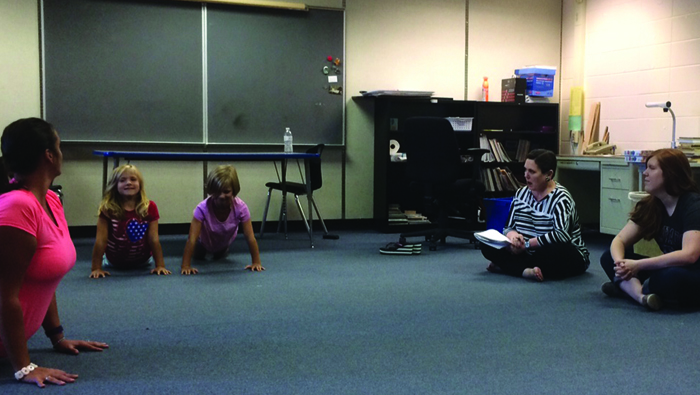
Connections between movement and learning are foundational at ESAA. Daily, students are engaged in a hands-on experiential learning where movement is encouraged. Teachers also incorporate specific movements, such as WOMMP (water, oxygen, march, midline and pretzel), rug routines and stretching exercises, throughout the day to focus and enhance learning.
During New Teacher Orientation on August 18th, our new teachers learned how these specific movements help improve engagement, memory and motivation. The Étude Group Dance and Movement teachers, Molly King and Libby Schmitz led a professional development session to help new teachers explore and experience these movements as they would be approached in the classroom.
The information shared through readings, explanation, modeling and practicing was based on research conducted at UW-Milwaukee by Dance Professor Dr. Marcia Parsons about how movement and emotion influence cognition. Teachers learned of the science behind WOMMP, rug routines and stretching exercises and the different benefits each provides.
WOMMP, a series of movements or actions done within the daily classroom meeting to help students’ minds and bodies get ready for learning, was explained, modeled, and practiced. This allowed new teachers to better understand the research behind the practice and also know how to apply the movements in their classroom. Ashley Gauger, 4/5 Multiage teacher, commented, “Learning about the purpose of each exercise helps me understand how I can use them in meaningfully in my classroom.” Rug routines, primarily done within our kindergarten classes, were demonstrated by ESAA students. Rug routines help develop the cerebellum and vestibular system. Practicing these routines weekly has shown to improve students’ attention and literacy development. Ms. King explained how stretching exercises can help relax muscles. Exercises to reduce eye and neck strain for reading and lower body stretches for math were modeled and practiced.
During the session, teachers asked many questions about when to integrate these movements into their classroom routine. At the end of the day, teachers reflected on what they learned, how their thinking changed and how they would implement movement and learning in their classrooms.



